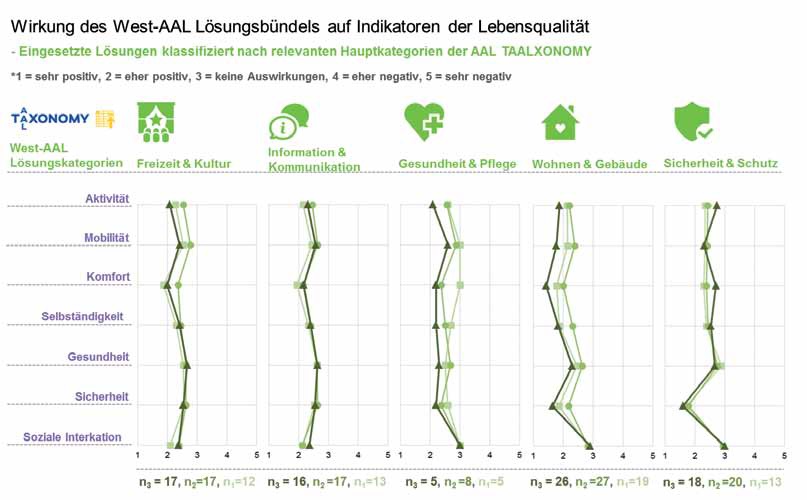WEST-AAL - Individual Bundled Solutions for the Elderly
Short Description
The vision of the WEST-AAL test region is to help preserve and improve the quality of life of the elderly, while taking into account their social environment and individual needs.
For this purpose, products, systems and services based on information and communication technologies are combined, developed and systematically evaluated by active participation of the test households involved.
The aim is to assist them to stay independent, safe and comfortable in their familiar environments with the help of a demand-oriented and customisable bundled solution.
Broad Market Analysis and Individual Test Packages
The WEST-AAL bundled solution consists of new technology-based assistive solutions from the AAL sector as well as state-of-the-art technologies. Selected products already available on the market (e.g. house automation) are enriched with AAL-relevant application scenarios and adapted to the requirements of the different test settings.
A comprehensive market analysis was carried out at the beginning of the project in order to be able to offer the test households a broad range of test scenarios in a wide range of applications. The solutions collected were evaluated from an organisational, ethical, legal and technological perspective and merged into a product catalogue.
In order to ensure usage beyond the pilot phase, each care-giving organisation and the individuals in their care (test households) were given the opportunity to create their own test packages based on organisational/ individual needs.
Sociodemographic Comparison in Evaluation
The individual solutions were tested using six different facilities from the care and social services sector in Tyrol and Vorarlberg. So far, 71 test households have been involved in the project since the start of the test phase.
The involvement of test households from different housing and care situations provides insight into local and organisational characteristics and enables sociodemographic as well as structural comparisons. The evaluation methods are diverse and range from standardised questionnaires and data analysis to qualitative methods such as focus groups, experience meetings, individual interviews and anonymous feedback sheets.
The evaluation results obtained so far are very positive from the perspective of the test households. The test subjects characterise the solutions mostly as meaningful, interesting and agreeable. In regular questionnaires to be completed every six weeks, the test subjects can evaluate the impact of the individual applications on seven indicators relating to quality of life (see figure for intermediate results).
All test packages used, including 19 different solutions and 42 applications, are assigned and evaluated on the basis of the AAL classification scheme (Taalxonomy).
Positive Impact on Safety and Comfort
The results from the surveys show that the applications concerning safety and protection as well as living and building have a very positive influence on people’s feeling of safety. According to the test subjects, applications concerning leisure and culture and information and communication increase social interaction. The two indicators mobility and comfort, in particular, are influenced positively by living and building solutions.
The solutions concerning health and care have apparently led to a growing positive influence on the indicator comfort over the course of time. According to the test subjects, no solution category had a negative impact on the quality of life indicators assessed. As part of the qualitative surveys, the various end user groups also expressed their willingness to continue to use the technologies after the end of the project.
Therefore, the aim is to introduce the measures necessary for the deployment of the bundled solutions in regular business operation.
Show Flats in Urban and Rural Areas
In order to make the project more visible, the potential and benefits of the solutions used are made accessible to the general public through demonstrations and empirical reports. The show flats are located in both urban and rural settings and are open to the public (Innsbruck: Residenz Veldidenapark; municipality of Kappl: Seniorenstube).
Project Partners
Consortium Manager
University of Innsbruck
Further Project Partners
- AIT Austrian Institute of Technology GmbH
- FAWO GmbH
- GEKKO it-solutions GmbH
- Innsbrucker Soziale Dienste GmbH
- Senioren Residenzen gemeinnützige
- Betriebsgesellschaft mbH
- Sozial- und Gesundheitssprengel St. Josef
- Sozialdienste Götzis Gesellschaft m. b. H.
- St. Anna-Hilfe für ältere Menschen
- gemeinnützige GmbH / Liebenau Österreich
- gemeinnützige GmbH
- UMIT – Private Universität für Gesundheitswissenschaften,
- Medizinische Informatik und
- Technik Gesellschaft mbH
- Vorarlberg University of Applied Sciences
- Wohn- und Pflegeheime der Stadtgemeinde Hall in Tirol
Contact Address
Project Coordinator
Mag.a Nesrin Ates
E-mail: nesrin.ates@uibk.ac.at

